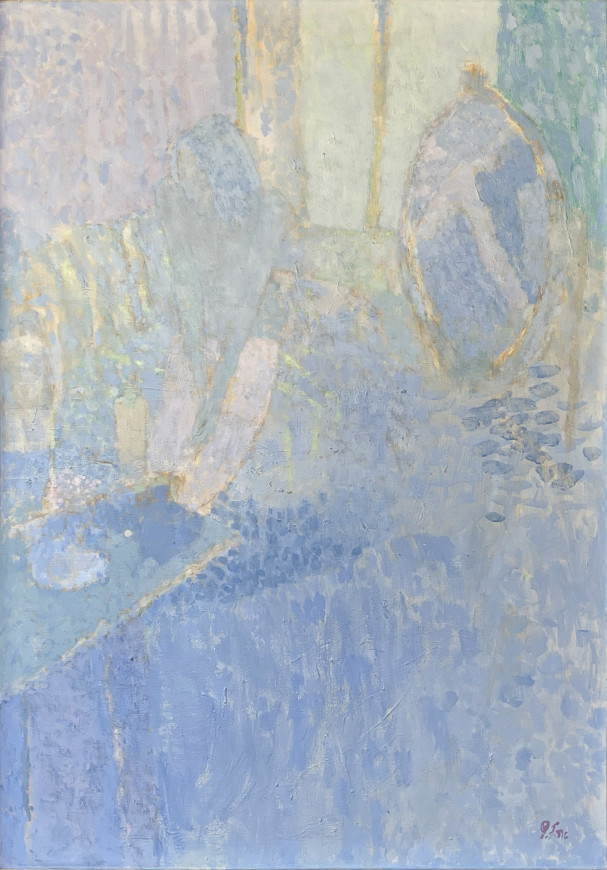-
Œuvres d'art
John FoxLe Miroir, 19681927-2008Acrylic on canvas50 x 35 in
127 x 88.9 cmSoldInscriptions
signed, 'J.Fox' (lower right); titled, ‘LE MIROIR’ (verso, upper horizontal stretcher)Provenance
Galerie Agnès Lefort, Montreal.
Private collection, Ontario.
Expositions
Montreal Museum of Fine Arts, Sondage 68 / Survey 68, March 8 to April 7, 1968, no. 93.
"John Fox’s painting represents his lifelong embrace of the world around him and the imaginative reinventions of that experience – both for himself and for everyone who celebrates the power and pleasure of art."
-Sandra Paikowsky, CM
Look at the image of this painting. While on your screen, try to visualize it in scale, 50 x 35 inches. Colour and light take precedence over the forms, including that of the seated woman who is reflected in the mirror. The result is a stunning composition providing immense visual pleasure.
For a biographical sketch and appreciation of John Fox, visit our John Fox artist page at this link: https://www.klinkhoff.ca/artists/106-john-fox/
Our professional background is steeped in “classics,” including the mastery of the Impressionists and Post-Impressionists of Canada and beyond, particularly France. Upon receiving “The Mirror”, Jonathan, Craig and I sat around discussing its virtues, relating this to other paintings by Fox as well, to Judith’s Hayes’s text of the John Fox retrospective at Galerie Walter Klinkhoff in 2010 and the text offered by Fox’s widow, scholar Sandra Paikowsky, at http://www.johnrichardfox.com/en/selected-work.
No one knows John Fox and his painting better than Sandra Paikowsky. Few have the scholarly background in art theory and art history to better describe Fox’s relation to art of his day and his influences. We are syphoning from her appreciation of John Fox a paragraph appropriate to the generation of “The Mirror.”
“Fox’s painting from the late 1950s to 1972 describes his fascination with the familiar and non-dramatic aspects of daily life. […] it reflects Fox’s interpretation of the visual concerns of Degas, Bonnard, Vuillard and Matisse. Their visual reinvention of the quiet dramas of modern life inspired Fox’s work throughout his career and would influence his lifelong definitions of art, whether his images were representational or abstract. Closer to home, his articulate and sensitive response to his own experiences of the world around him suggests the concerns of such Montreal painters as John Lyman and Goodridge Roberts along with David Milne in Ontario. But most important to Fox was the work of James Wilson Morrice, whose quiet narratives encapsulate a moment in time without sentiment or artifice. Morrice’s sensitivity to the harmonious composing of shapes, spaces and tonalities inspired Fox’s images and his own painterly fusion of looking and transcribing what he saw and what he felt. In contrast to many other Canadian figurative artists at the time, Fox had little interest in the grand narratives of the dramatic landscape. Instead, he preferred to paint those profound, intimate aspects of people, places and things that define the collective moments of our lives. It was this alternative vision of art that make Fox’s early work so important for redefining Canadian modernism and its new ways of expressing the familiar and the personal.”
We do encourage readers to visit the following link to uncover a greater appreciation of Fox's career: http://www.johnrichardfox.com/en/selected-work
John Fox was recognized with a purchase by the National Gallery of Canada in 1955. Around this time Blair Laing was exhibiting John Fox in Toronto. Subsequently Roberts Gallery showcased his paintings and later Mira Godard Gallery. In Montreal, the legendary Montreal art gallery William Watson exhibited and sold his work. Upon Watson’s closing, he then had 4 exhibitions with Vilma Shima’s Continental Galleries and then moved to Agnes Lefort from 1965.
Followers of our former family gallery Galerie Walter Klinkhoff will remember the posthumous retrospective we hosted in honour of John Fox in September of 2010. As a foreword to the outstanding text in the catalogue written by Judith Hayes, M.A. I wrote with pride, “Although I cannot claim any close friendship with John Fox, my wife Helen and I have been long-time admirers of his work and have three large scale compositions by him in our home.” We had considered him particularly in the context of an evolution from Morrice and Bonnard.
As we received “The Mirror” by Fox, a couple of resellers were promoting exquisite Claude Monet paintings, one from the Waterloo series, and the other from his series of water lilies, paintings which have since been sold for USD 48,000,000 and USD 70,000,000 respectively. John Fox most certainly references the best of Claude Monet in addition to those previously mentioned as an important influence.
Judith Hayes echoed Sandra’s remarks; “Fox’s body of work speaks of a man whose life was totally committed to making art. It was also his lasting gift to those who shared his passion for the pleasures of painting.” See https://www.klinkhoff.ca/artists/106-john-fox/. As readers should expect, we invite your purchase of “The Mirror,” 1968 by John Fox.














